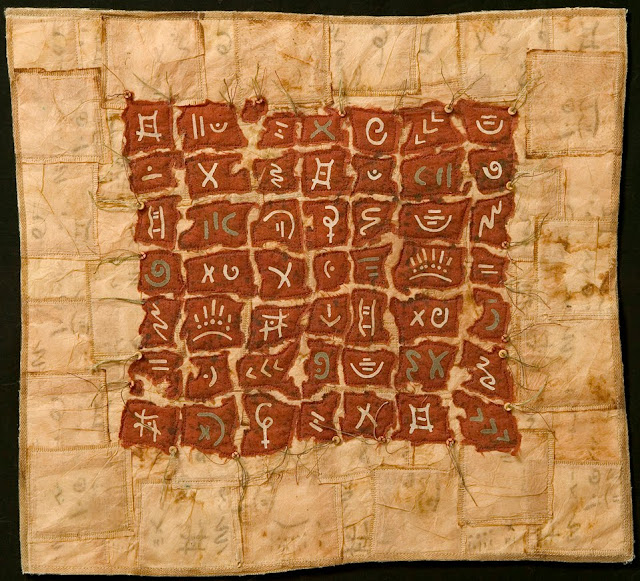Illustration: Tricia Coulson. Artifacts 3.
There is an obvious early historical element to the textile work of Tricia Coulson, though perhaps it would be better to say that her work is pre-historical and taps into some of the most fundamental of the roots of the human species, the early ancestral elements that went to make up who we are today, the core of our being rather than the ephemeral and somehow unreliable coating that the twenty first century at least appears to give us.
Illustration: Tricia Coulson. Artifacts 4.
It is the strands within our human journey that seem to make up such an important part of Coulson's work. Two strands in particular seem to stand out in the pieces shown in this article, that of both visible art and of the written word. It could be said that these two elements are possibly the two strands that have helped us the most in moulding our exceptional ability to be both creative and perhaps more importantly, to understand that creative element inside all of us.
Illustration: Tricia Coulson. Artifacts 1.
Although the written word followed on much later than the medium of art, the early lettering on these art pieces could be said to be representational of the spoken as well as the written word. This would then take the images that Coulson has conjured up, back to the earliest days of human myth and legend, when our culture was young, fluid and full of stories and images of wonder concerning the world we saw and experienced around us.
Illustration: Tricia Coulson. Artifacts 2.
The way Coulson produces her work and judges the compositional components that make up each piece is interesting, as it seems to tie in with the timeless quality of her compositions. She removes herself from the measured timeframe of our everyday life today and creates her own space and rhythm in which to work. This conscious removal from the structure of time and limited space opens up a whole world of possibilities and allows her to experience a genuine contact with the larger world that our ancestors knew, rather than the very narrow one that we inhabit today which is full of the power of the rigid framework of time and space that we have created for ourselves as both a useful guide, but which also serves as a cage with a host of inevitable limitations. By opening up this other world that our early ancestors knew intimately, Coulson shows us what we could and have been, rather than what we are. It gives us hope for change, but it is also tinged with the sadness of what we have inevitably lost, probably forever.
Illustration: Tricia Coulson. Pictograph.
Coulson has a website showing her work and statements about her approach to that work. The website can be found here.





